Advanced Routing Project: ITNE3007 Configuration and Troubleshooting
VerifiedAdded on 2023/04/23
|11
|975
|326
Project
AI Summary
This project involves configuring and troubleshooting Border Gateway Protocol (BGP) in a network environment using GNS3 software. The assignment requires configuring routers to exchange routing information with two Internet Service Providers (ISPs). The solution begins with the initial setup of the network, including device names and configurations for ISP1 and Melbourne3. It then proceeds through a series of steps detailing BGP configuration on the routers, including setting up neighbor relationships and network advertisements. The project includes the configuration of loopback interfaces and serial interfaces. The solution also addresses questions about the BGP state, router ID, and the interpretation of routing table outputs. The student provides screenshots of the configurations and answers to specific questions about routing table symbols and BGP states. The assignment aims to provide a practical understanding of BGP configuration and its role in inter-network communication, including the analysis of routing tables and the troubleshooting of BGP connections.
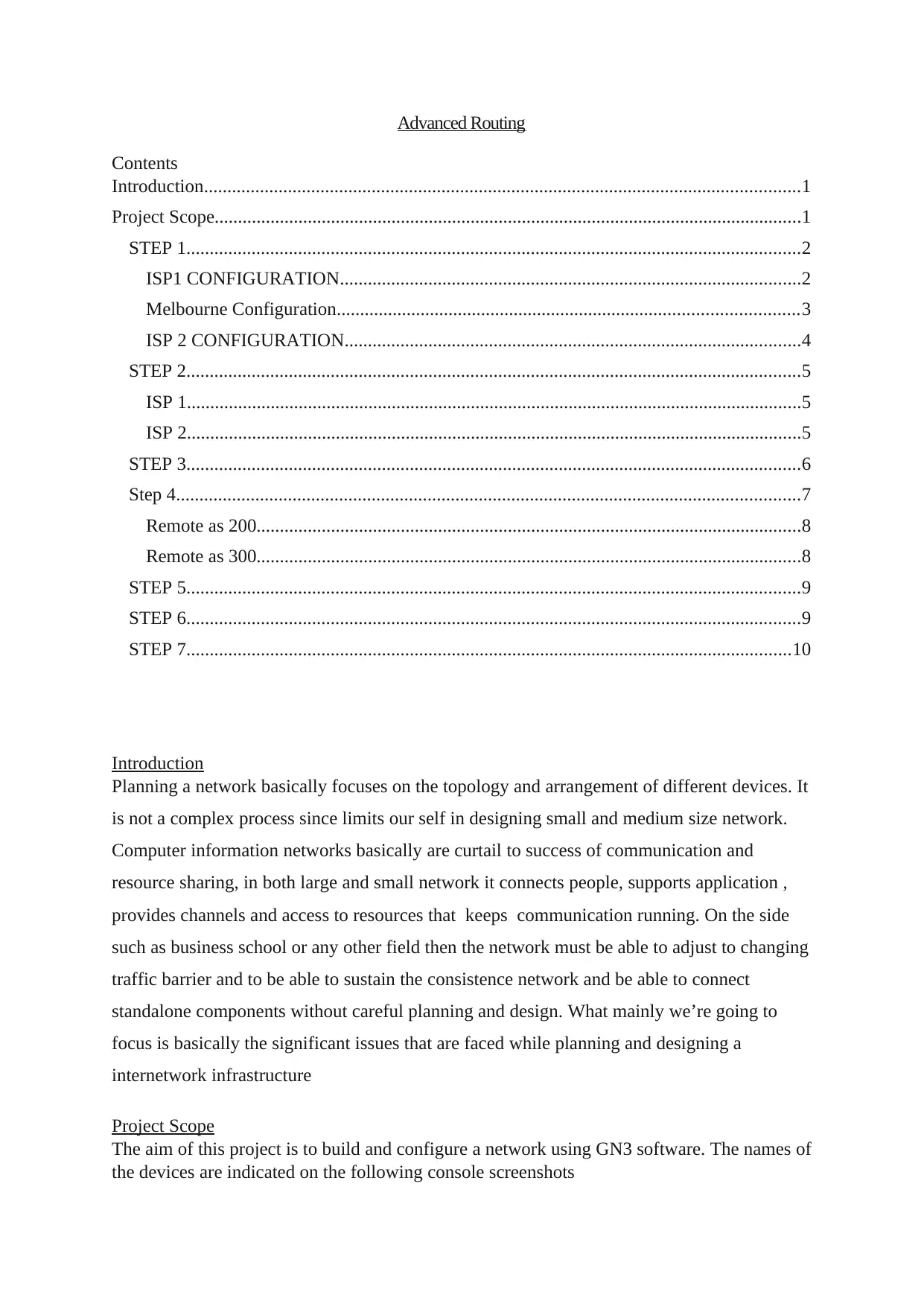
Advanced Routing
Contents
Introduction................................................................................................................................1
Project Scope..............................................................................................................................1
STEP 1....................................................................................................................................2
ISP1 CONFIGURATION...................................................................................................2
Melbourne Configuration...................................................................................................3
ISP 2 CONFIGURATION..................................................................................................4
STEP 2....................................................................................................................................5
ISP 1....................................................................................................................................5
ISP 2....................................................................................................................................5
STEP 3....................................................................................................................................6
Step 4......................................................................................................................................7
Remote as 200.....................................................................................................................8
Remote as 300.....................................................................................................................8
STEP 5....................................................................................................................................9
STEP 6....................................................................................................................................9
STEP 7..................................................................................................................................10
Introduction
Planning a network basically focuses on the topology and arrangement of different devices. It
is not a complex process since limits our self in designing small and medium size network.
Computer information networks basically are curtail to success of communication and
resource sharing, in both large and small network it connects people, supports application ,
provides channels and access to resources that keeps communication running. On the side
such as business school or any other field then the network must be able to adjust to changing
traffic barrier and to be able to sustain the consistence network and be able to connect
standalone components without careful planning and design. What mainly we’re going to
focus is basically the significant issues that are faced while planning and designing a
internetwork infrastructure
Project Scope
The aim of this project is to build and configure a network using GN3 software. The names of
the devices are indicated on the following console screenshots
Contents
Introduction................................................................................................................................1
Project Scope..............................................................................................................................1
STEP 1....................................................................................................................................2
ISP1 CONFIGURATION...................................................................................................2
Melbourne Configuration...................................................................................................3
ISP 2 CONFIGURATION..................................................................................................4
STEP 2....................................................................................................................................5
ISP 1....................................................................................................................................5
ISP 2....................................................................................................................................5
STEP 3....................................................................................................................................6
Step 4......................................................................................................................................7
Remote as 200.....................................................................................................................8
Remote as 300.....................................................................................................................8
STEP 5....................................................................................................................................9
STEP 6....................................................................................................................................9
STEP 7..................................................................................................................................10
Introduction
Planning a network basically focuses on the topology and arrangement of different devices. It
is not a complex process since limits our self in designing small and medium size network.
Computer information networks basically are curtail to success of communication and
resource sharing, in both large and small network it connects people, supports application ,
provides channels and access to resources that keeps communication running. On the side
such as business school or any other field then the network must be able to adjust to changing
traffic barrier and to be able to sustain the consistence network and be able to connect
standalone components without careful planning and design. What mainly we’re going to
focus is basically the significant issues that are faced while planning and designing a
internetwork infrastructure
Project Scope
The aim of this project is to build and configure a network using GN3 software. The names of
the devices are indicated on the following console screenshots
Paraphrase This Document
Need a fresh take? Get an instant paraphrase of this document with our AI Paraphraser
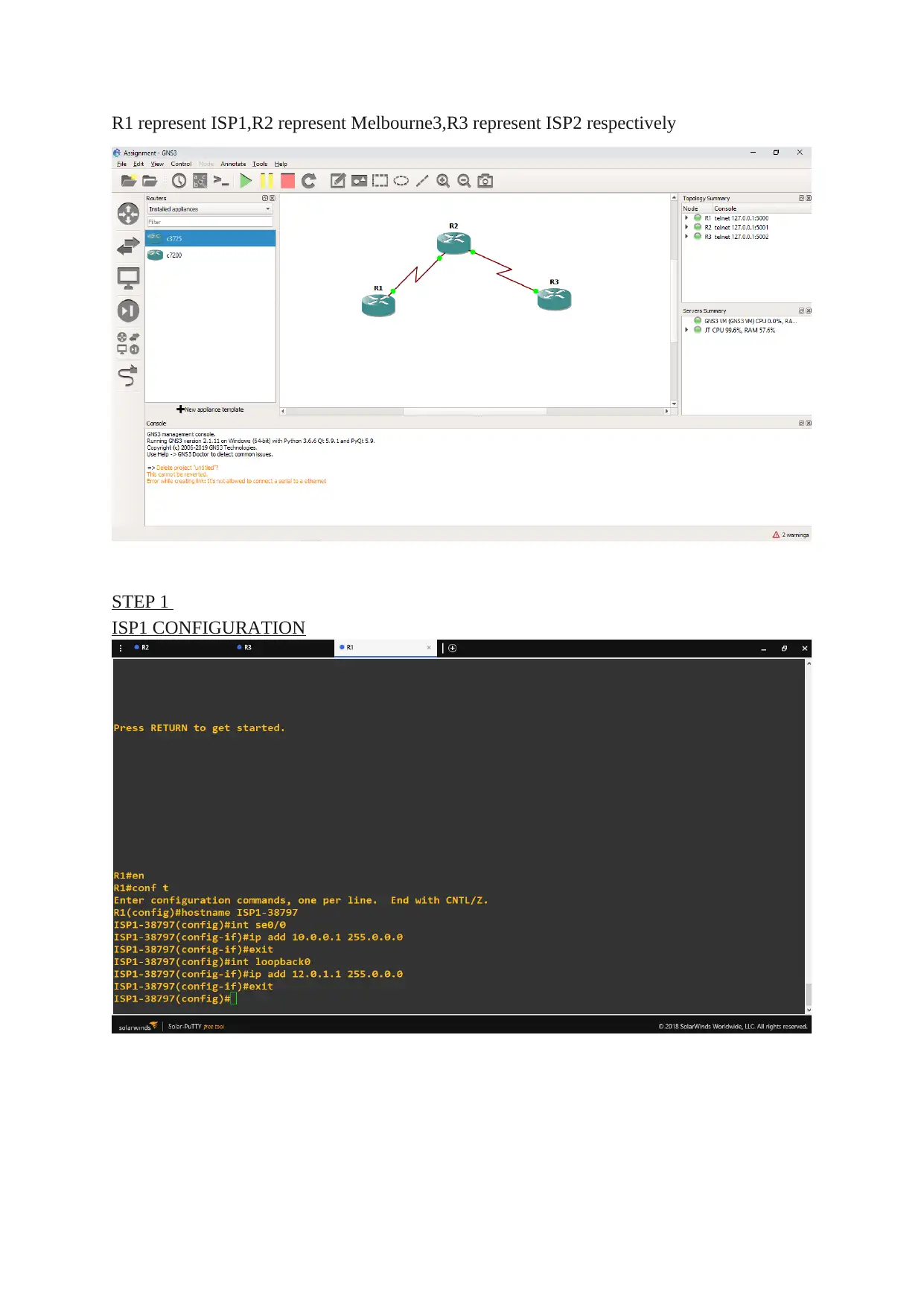
R1 represent ISP1,R2 represent Melbourne3,R3 represent ISP2 respectively
STEP 1
ISP1 CONFIGURATION
STEP 1
ISP1 CONFIGURATION
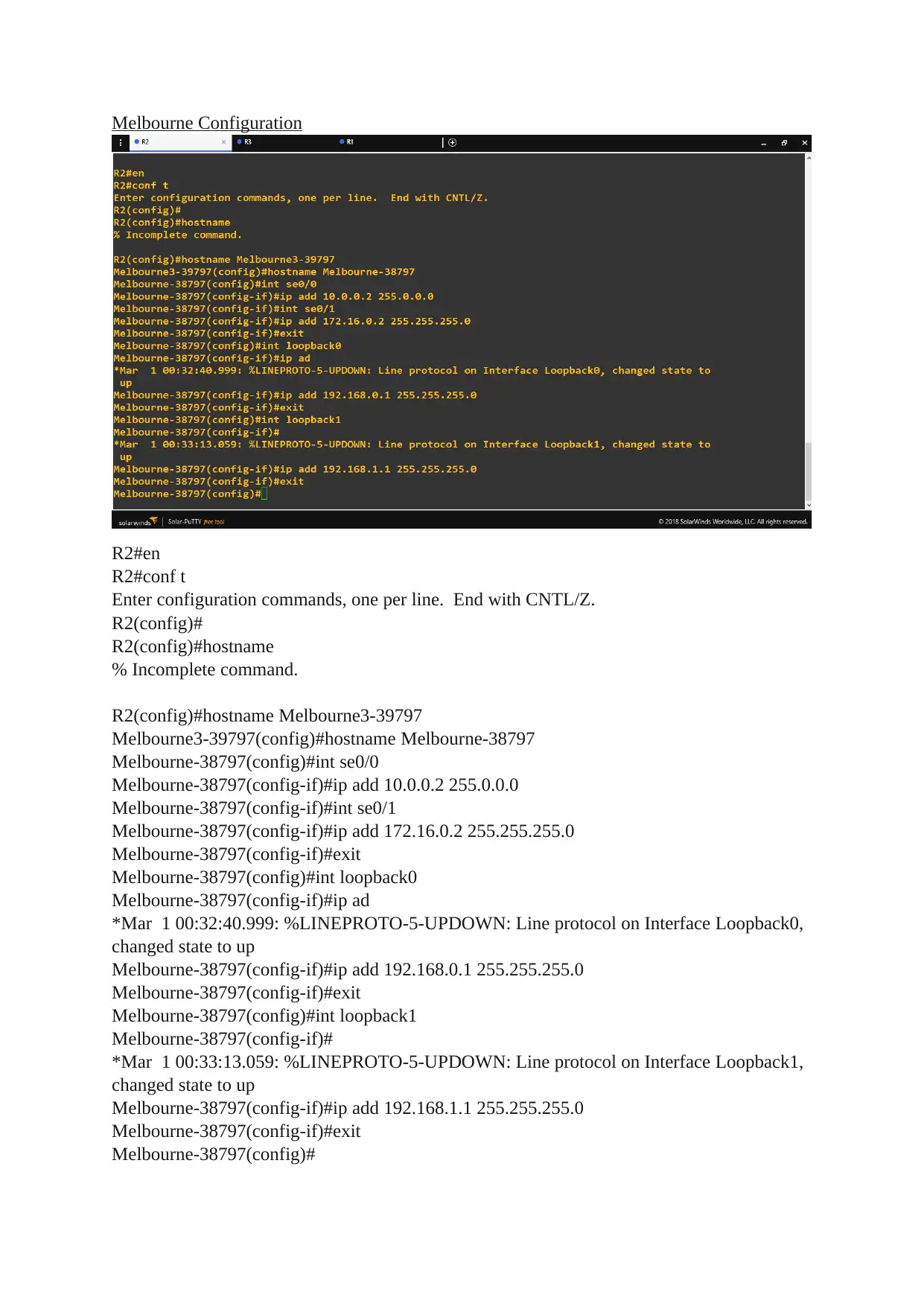
Melbourne Configuration
R2#en
R2#conf t
Enter configuration commands, one per line. End with CNTL/Z.
R2(config)#
R2(config)#hostname
% Incomplete command.
R2(config)#hostname Melbourne3-39797
Melbourne3-39797(config)#hostname Melbourne-38797
Melbourne-38797(config)#int se0/0
Melbourne-38797(config-if)#ip add 10.0.0.2 255.0.0.0
Melbourne-38797(config-if)#int se0/1
Melbourne-38797(config-if)#ip add 172.16.0.2 255.255.255.0
Melbourne-38797(config-if)#exit
Melbourne-38797(config)#int loopback0
Melbourne-38797(config-if)#ip ad
*Mar 1 00:32:40.999: %LINEPROTO-5-UPDOWN: Line protocol on Interface Loopback0,
changed state to up
Melbourne-38797(config-if)#ip add 192.168.0.1 255.255.255.0
Melbourne-38797(config-if)#exit
Melbourne-38797(config)#int loopback1
Melbourne-38797(config-if)#
*Mar 1 00:33:13.059: %LINEPROTO-5-UPDOWN: Line protocol on Interface Loopback1,
changed state to up
Melbourne-38797(config-if)#ip add 192.168.1.1 255.255.255.0
Melbourne-38797(config-if)#exit
Melbourne-38797(config)#
R2#en
R2#conf t
Enter configuration commands, one per line. End with CNTL/Z.
R2(config)#
R2(config)#hostname
% Incomplete command.
R2(config)#hostname Melbourne3-39797
Melbourne3-39797(config)#hostname Melbourne-38797
Melbourne-38797(config)#int se0/0
Melbourne-38797(config-if)#ip add 10.0.0.2 255.0.0.0
Melbourne-38797(config-if)#int se0/1
Melbourne-38797(config-if)#ip add 172.16.0.2 255.255.255.0
Melbourne-38797(config-if)#exit
Melbourne-38797(config)#int loopback0
Melbourne-38797(config-if)#ip ad
*Mar 1 00:32:40.999: %LINEPROTO-5-UPDOWN: Line protocol on Interface Loopback0,
changed state to up
Melbourne-38797(config-if)#ip add 192.168.0.1 255.255.255.0
Melbourne-38797(config-if)#exit
Melbourne-38797(config)#int loopback1
Melbourne-38797(config-if)#
*Mar 1 00:33:13.059: %LINEPROTO-5-UPDOWN: Line protocol on Interface Loopback1,
changed state to up
Melbourne-38797(config-if)#ip add 192.168.1.1 255.255.255.0
Melbourne-38797(config-if)#exit
Melbourne-38797(config)#
⊘ This is a preview!⊘
Do you want full access?
Subscribe today to unlock all pages.

Trusted by 1+ million students worldwide
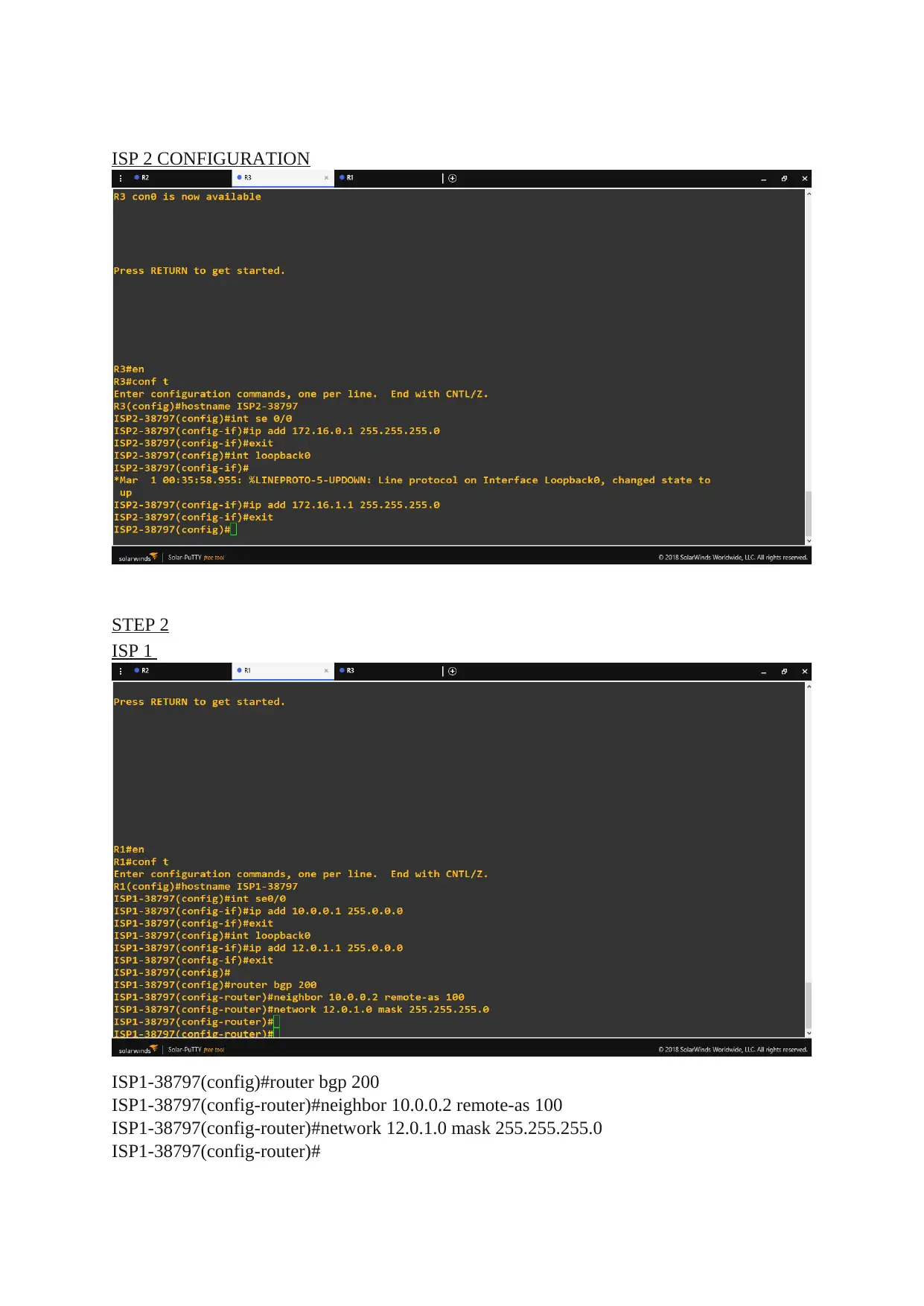
ISP 2 CONFIGURATION
STEP 2
ISP 1
ISP1-38797(config)#router bgp 200
ISP1-38797(config-router)#neighbor 10.0.0.2 remote-as 100
ISP1-38797(config-router)#network 12.0.1.0 mask 255.255.255.0
ISP1-38797(config-router)#
STEP 2
ISP 1
ISP1-38797(config)#router bgp 200
ISP1-38797(config-router)#neighbor 10.0.0.2 remote-as 100
ISP1-38797(config-router)#network 12.0.1.0 mask 255.255.255.0
ISP1-38797(config-router)#
Paraphrase This Document
Need a fresh take? Get an instant paraphrase of this document with our AI Paraphraser
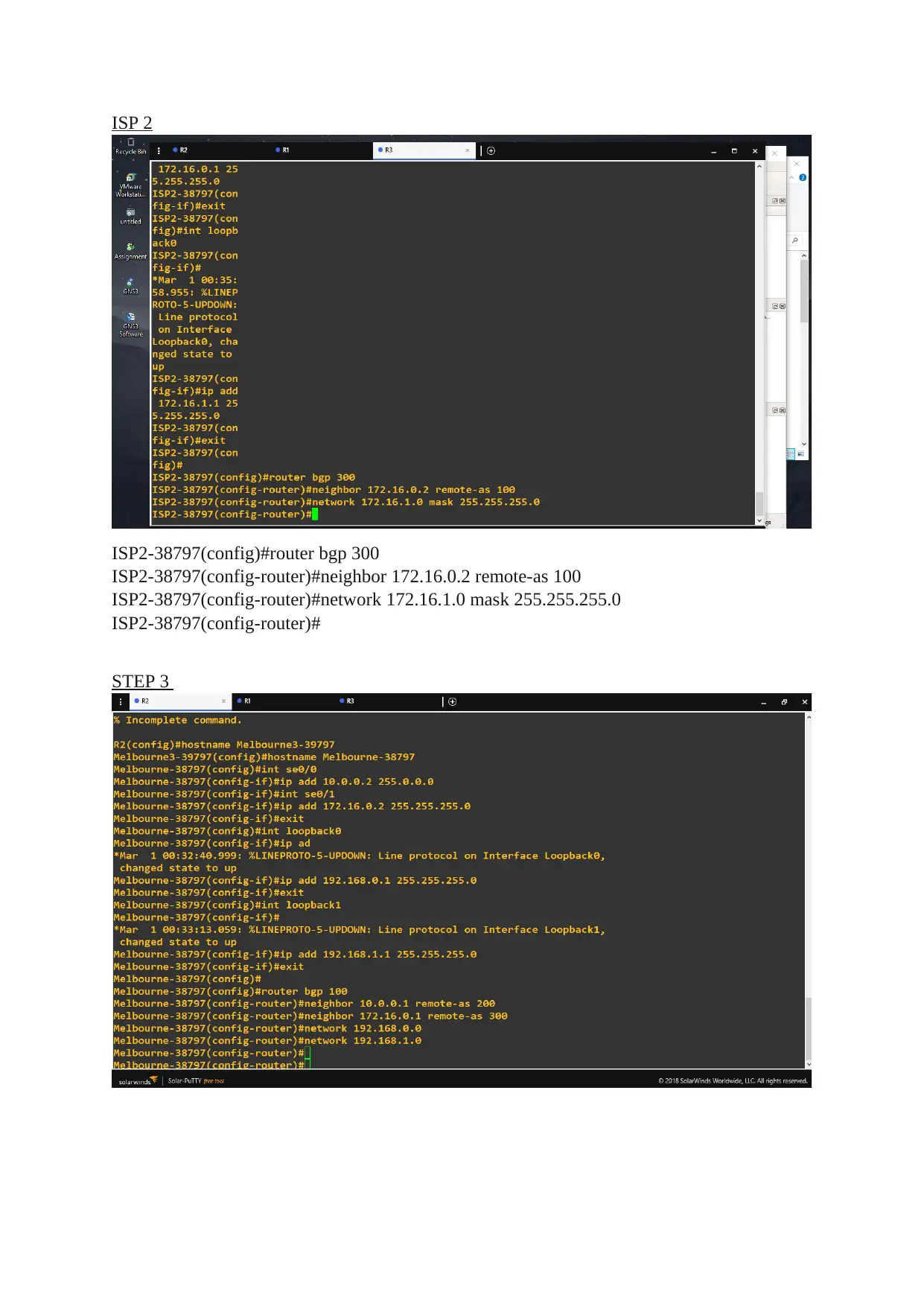
ISP 2
ISP2-38797(config)#router bgp 300
ISP2-38797(config-router)#neighbor 172.16.0.2 remote-as 100
ISP2-38797(config-router)#network 172.16.1.0 mask 255.255.255.0
ISP2-38797(config-router)#
STEP 3
ISP2-38797(config)#router bgp 300
ISP2-38797(config-router)#neighbor 172.16.0.2 remote-as 100
ISP2-38797(config-router)#network 172.16.1.0 mask 255.255.255.0
ISP2-38797(config-router)#
STEP 3
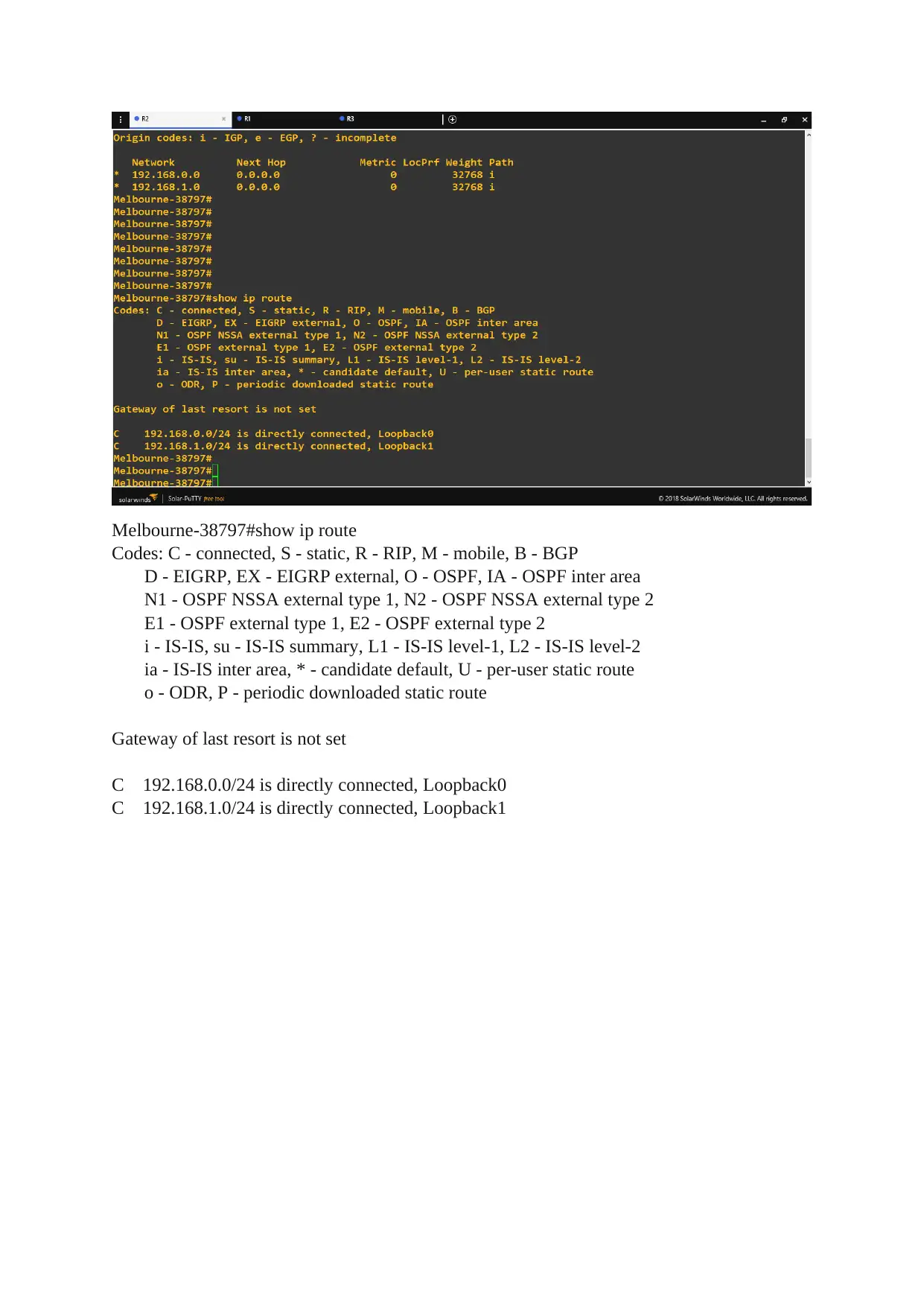
Melbourne-38797#show ip route
Codes: C - connected, S - static, R - RIP, M - mobile, B - BGP
D - EIGRP, EX - EIGRP external, O - OSPF, IA - OSPF inter area
N1 - OSPF NSSA external type 1, N2 - OSPF NSSA external type 2
E1 - OSPF external type 1, E2 - OSPF external type 2
i - IS-IS, su - IS-IS summary, L1 - IS-IS level-1, L2 - IS-IS level-2
ia - IS-IS inter area, * - candidate default, U - per-user static route
o - ODR, P - periodic downloaded static route
Gateway of last resort is not set
C 192.168.0.0/24 is directly connected, Loopback0
C 192.168.1.0/24 is directly connected, Loopback1
Codes: C - connected, S - static, R - RIP, M - mobile, B - BGP
D - EIGRP, EX - EIGRP external, O - OSPF, IA - OSPF inter area
N1 - OSPF NSSA external type 1, N2 - OSPF NSSA external type 2
E1 - OSPF external type 1, E2 - OSPF external type 2
i - IS-IS, su - IS-IS summary, L1 - IS-IS level-1, L2 - IS-IS level-2
ia - IS-IS inter area, * - candidate default, U - per-user static route
o - ODR, P - periodic downloaded static route
Gateway of last resort is not set
C 192.168.0.0/24 is directly connected, Loopback0
C 192.168.1.0/24 is directly connected, Loopback1
⊘ This is a preview!⊘
Do you want full access?
Subscribe today to unlock all pages.

Trusted by 1+ million students worldwide
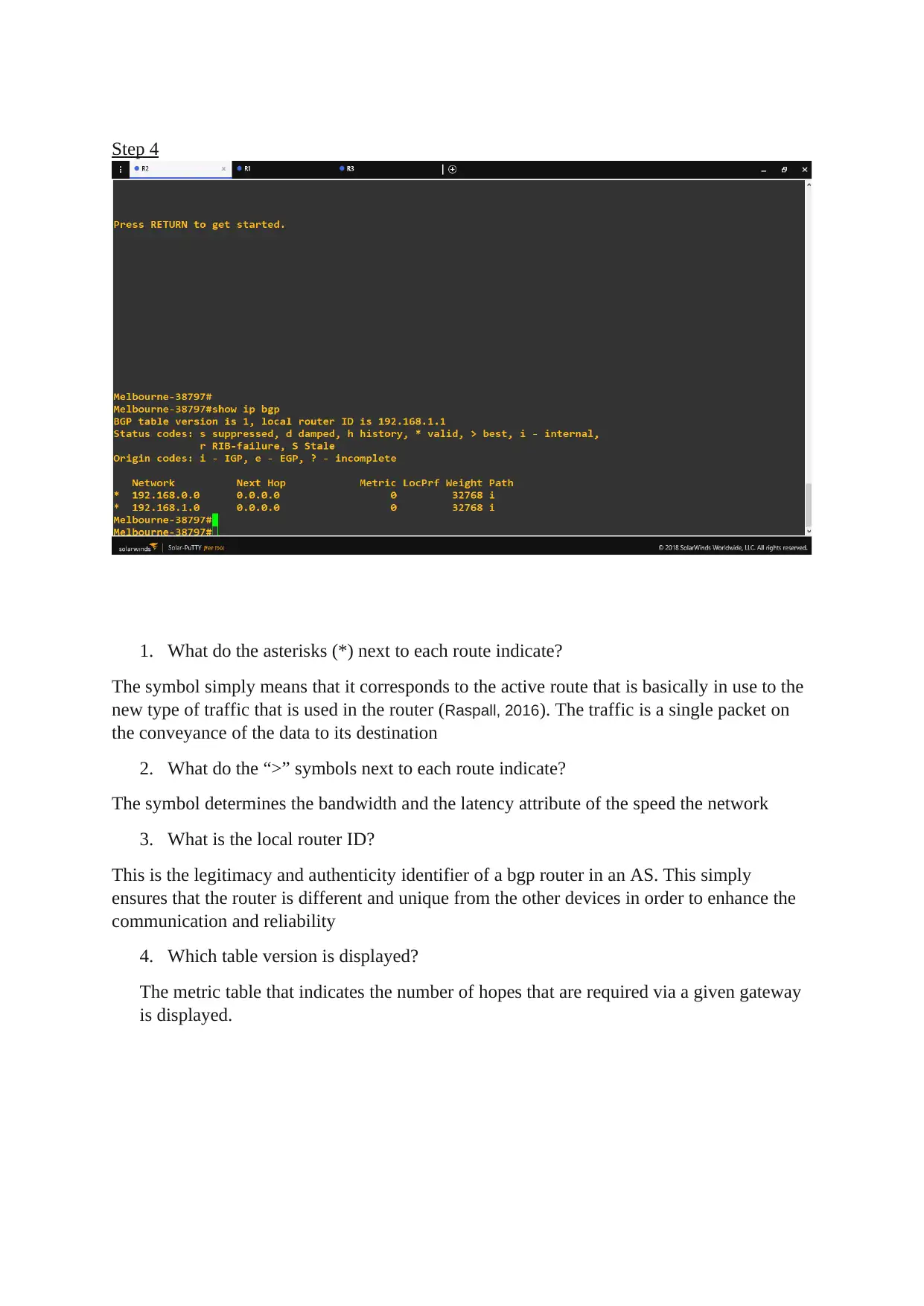
Step 4
1. What do the asterisks (*) next to each route indicate?
The symbol simply means that it corresponds to the active route that is basically in use to the
new type of traffic that is used in the router (Raspall, 2016). The traffic is a single packet on
the conveyance of the data to its destination
2. What do the “>” symbols next to each route indicate?
The symbol determines the bandwidth and the latency attribute of the speed the network
3. What is the local router ID?
This is the legitimacy and authenticity identifier of a bgp router in an AS. This simply
ensures that the router is different and unique from the other devices in order to enhance the
communication and reliability
4. Which table version is displayed?
The metric table that indicates the number of hopes that are required via a given gateway
is displayed.
1. What do the asterisks (*) next to each route indicate?
The symbol simply means that it corresponds to the active route that is basically in use to the
new type of traffic that is used in the router (Raspall, 2016). The traffic is a single packet on
the conveyance of the data to its destination
2. What do the “>” symbols next to each route indicate?
The symbol determines the bandwidth and the latency attribute of the speed the network
3. What is the local router ID?
This is the legitimacy and authenticity identifier of a bgp router in an AS. This simply
ensures that the router is different and unique from the other devices in order to enhance the
communication and reliability
4. Which table version is displayed?
The metric table that indicates the number of hopes that are required via a given gateway
is displayed.
Paraphrase This Document
Need a fresh take? Get an instant paraphrase of this document with our AI Paraphraser

Remote as 200
Remote as 300
5. Based on the output of this command, what is the BGP state between this router and
ISP2?
Connect state it will finish all the 3 way TCP handshake.
Open Sent state, the router simply send a confirmatory message to commence a TCP
Connection (YANG and TANG, 2013).
Open Confirm state router get a confirmation for TCP neighbour around them
Remote as 300
5. Based on the output of this command, what is the BGP state between this router and
ISP2?
Connect state it will finish all the 3 way TCP handshake.
Open Sent state, the router simply send a confirmatory message to commence a TCP
Connection (YANG and TANG, 2013).
Open Confirm state router get a confirmation for TCP neighbour around them
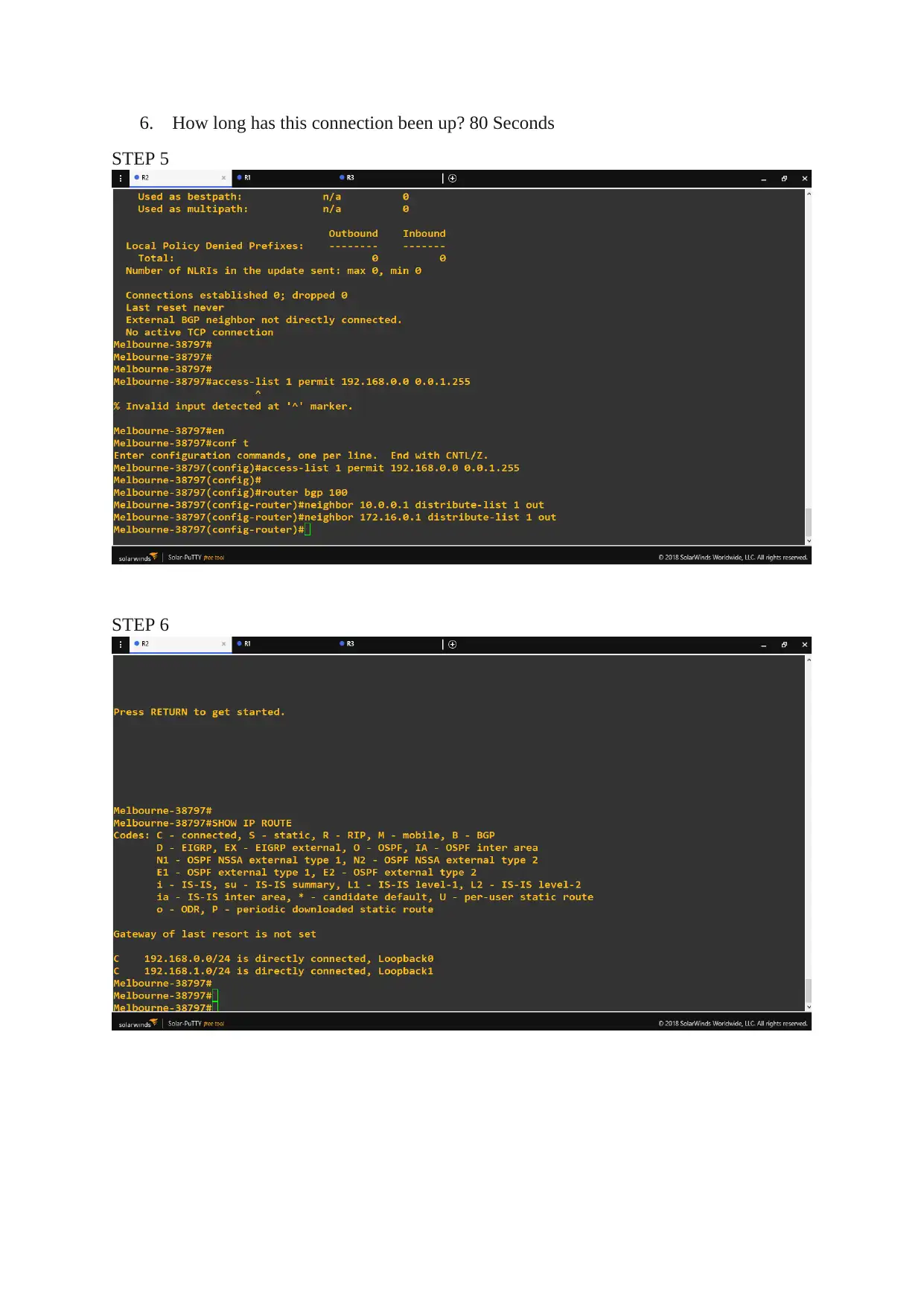
6. How long has this connection been up? 80 Seconds
STEP 5
STEP 6
STEP 5
STEP 6
⊘ This is a preview!⊘
Do you want full access?
Subscribe today to unlock all pages.

Trusted by 1+ million students worldwide

STEP 7
Paraphrase This Document
Need a fresh take? Get an instant paraphrase of this document with our AI Paraphraser

References
Raspall, F., 2016. Building Nemo, a system to monitor IP routing and traffic paths in real
time. Computer Networks, 97, pp.1-30.
YANG, Y.F. and TANG, F.X., 2013. Research on the Teaching Reformation of Computer Network
Curriculum Based on Simulation Software GN3. Computer Knowledge and Technology, 8, p.046.
Raspall, F., 2016. Building Nemo, a system to monitor IP routing and traffic paths in real
time. Computer Networks, 97, pp.1-30.
YANG, Y.F. and TANG, F.X., 2013. Research on the Teaching Reformation of Computer Network
Curriculum Based on Simulation Software GN3. Computer Knowledge and Technology, 8, p.046.
1 out of 11
Related Documents
Your All-in-One AI-Powered Toolkit for Academic Success.
+13062052269
info@desklib.com
Available 24*7 on WhatsApp / Email
![[object Object]](/_next/static/media/star-bottom.7253800d.svg)
Unlock your academic potential
Copyright © 2020–2025 A2Z Services. All Rights Reserved. Developed and managed by ZUCOL.

